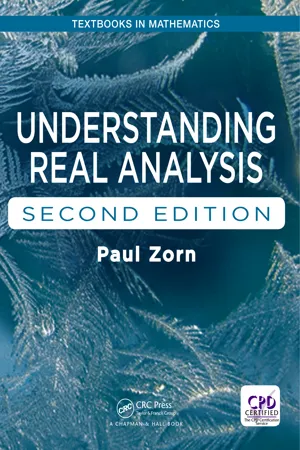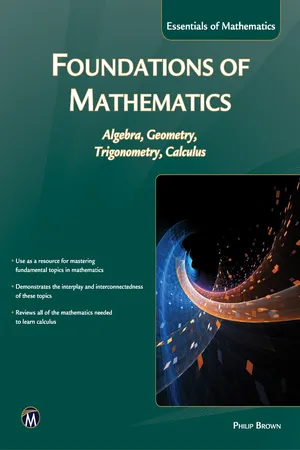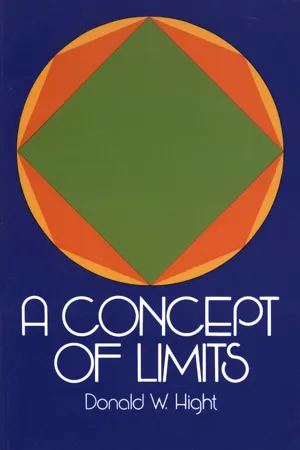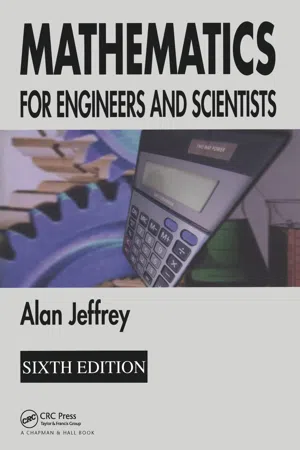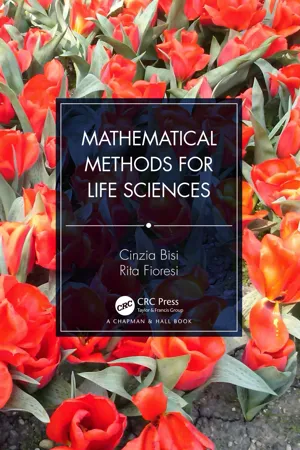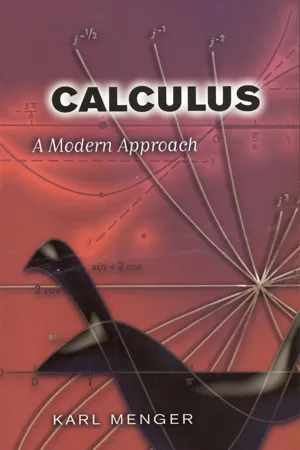Mathematics
Limits at Infinity
Limits at infinity refer to the behavior of a function as the input values approach positive or negative infinity. In mathematical terms, a limit at infinity is used to describe the long-term behavior of a function. It helps determine the value that a function approaches as the input values become increasingly large or small.
Written by Perlego with AI-assistance
Related key terms
Related key terms
1 of 4
Related key terms
1 of 3
8 Key excerpts on "Limits at Infinity"
- Mark Ryan(Author)
- 2023(Publication Date)
- For Dummies(Publisher)
14 .) Now, it turns out that after you learn the shortcuts for calculating derivatives and integrals, you won’t need to use the longer limit methods anymore. But understanding the mathematics of limits is nonetheless important because it forms the foundation upon which the vast architecture of calculus is built (okay, so I got a bit carried away there). In this chapter, I lay the groundwork for differentiation and integration by exploring limits and the closely related topic, continuity.Take It to the Limit — NOT
Limits can be tricky. Don’t worry if you don’t grasp the concept right away.Informal definition oflimit(the formal definition is in a few pages): The limit of a function (if it exists) for some x -value c is the height the function gets closer and closer to as x gets closer and closer to c from the left and the right. (Note: This definition does not apply to limits where x approaches infinity or negative infinity. More about those limits later in this chapter and in Chapter 8 .)Got it? You’re kidding! Let me say it another way. A function has a limit for a given x -value c if the function zeros in on some height as x gets closer and closer to the given value c from the left and the right. Did that help? I didn’t think so. It’s much easier to understand limits through examples than through this sort of mumbo jumbo, so let’s take a look at some.Using three functions to illustrate the same limit
Consider the function , shown on the left in Figure 7-1 . When we say that the limit of as x approaches 2 is 7, written as , we mean that as x gets closer and closer to 2 from the left and the right, gets closer and closer to a height of 7. By the way, as far as I know, the number 2 in this example doesn’t have a formal name, but I call it the arrow-number . The arrow-number gives you a horizontal location in the x direction. Don’t confuse it with the answer to the limit problem, called the limit, which refers to a y -value or height of the function (7 in this example). Now, look at Table 7-1- eBook - ePub
The Learning and Teaching of Calculus
Ideas, Insights and Activities
- John Monaghan, Robert Ely, Márcia M.F. Pinto, Mike Thomas(Authors)
- 2023(Publication Date)
- Routledge(Publisher)
We wrote earlier, “The rigorous/informal question is a real tension for teachers and one that underpins much of what we discuss in this chapter”. This section explores this tension by contrasting mathematical accounts of limits and continuity with possible student interpretations. Our main focus is the meanings given to the term ‘limit’, but we also consider continuity and the terms ‘approaches’ and ‘converges’; this focus mirrors the foci of mathematics education research in this area.A first discussion of limits in a calculus classroom may concern limits of sequences or limits of functions. We consider sequences first. Spivak (2008) is a well-respected calculus book. Its chapter on infinite sequences starts (p. 372):The idea of an infinite sequence is so natural a concept that it is tempting to dispense with a definition altogether. One frequently writes simply “an infinite sequence a1 , a2 , a3 , a4 , a5 , …” the three dots indicating that the numbers ai continue to the right “forever”.Spivak then provides a definition, “An infinite sequence of real numbers is a function whose domain is ℕ”. We do not disagree with this description or definition, but we have some questions from the student point of view:EdumatterConsider the following:- Why are sequences introduced in a calculus course? What is their role in developing the ideas of differentiation and integration?
- How natural do students find an infinite sequence? What examples of infinite sequences in nature might they have experience of?
- What does ‘forever’ mean? To the mathematician this word is atemporal, the sequence does not develop over time, but the student may bring time into their ideas on the matter, “How can something go on forever? You’d run out of time”.
- The definition describes an infinite sequence as a function. To the mathematician this is clear because a function, f, is a set of ordered pairs of numbers such that if (a, b) ∈ f and (a, c) ∈ f, then b = c and the first member of each ordered pair in the infinite sequence is a natural number (the suffixes in a1 , a2 , a3 , a4 , a5
- eBook - ePub
- Paul Zorn(Author)
- 2017(Publication Date)
- Chapman and Hall/CRC(Publisher)
The squeezing inequality needs proof too, of course; we’ll leave that to the exercises to avoid distraction. ♢ Beyond Vanilla: More Limit Flavors We’ll find uses for several variations on the basic limit theme discussed above. Here are some samples of Limits at Infinity and infinite limits : lim x → ∞ 4 x + 3 2 x + 1 = 2 ; lim x → 0 1 x 2 = ∞ ; lim x → - ∞ (x 2 - x 3) = ∞. Here are some one - sided. limits: lim x → 0 + ln x = - ∞ ; lim x → 0 + x 1 + x = 0 ; lim x → 3 - x - 3 | 3 - x | = - 1. Familiar functions from calculus seldom cause trouble on this score. Following are several formal definitions; we leave some others, all in the same spirit, as exercises. As with Definition 3.1, each part here involves some technical assumption about domains, needed to ensure that the key inequalities make sense. Definition 3.5 (Variant limits). Let f be function and let a and L be real numers. • Right-hand limit: Let f (x) be defined for all inputs x in some open interval I = (a, b). We say lim x → a + f (x) = L if, for every ɛ > 0, there exists δ > 0 such that | f (x) - L | < ɛ whenever x ∊ I and a < x < a + δ. • Left-hand infinite limit: Let f (x) be defined for all inputs x in some open interval I = (b, a). We say lim x → a - f (x) = - ∞ if, for every M > 0, there exists δ > 0 such that f (x) < - M whenever x ∊ I and a - δ < x < a. • Limit at infinity : Let f (x) be defined for all inputs x in some open interval I = (b, ∞). We say lim x →∞ f (x) = L if, for every ɛ > 0, there exists N > 0 such that | f (x) - L | < ɛ whenever x ∊ I and x > N. • Infinite (two-sided) limit : Let f (x) be defined for all inputs x in an open interval I containing a, except perhaps at x = a. We say lim x → a f (x) = ∞ if, for every M > 0, there exists δ > 0 such that f (x) > M whenever x ∊ I and 0 < | x - a | < δ. • Infinite limit at infinity : Let f (x) be defined for all inputs x in some open interval I = (b, ∞) - eBook - ePub
Foundations of Mathematics
Algebra, Geometry, Trigonometry and Calculus
- Philip Brown(Author)
- 2016(Publication Date)
- Mercury Learning and Information(Publisher)
7LIMITS
7.1INTRODUCTION
The concept of a limiting value of a function plays an important role in calculus, because the formal definition of the derivative of a function at a point in its domain can be expressed as the limiting value of a particular expression involving the function.The meaning of “limit” in mathematics is more subtle than that in everyday speech. A speed limit that applies on a highway is a speed that motorists may not exceed. The meaning of “limit” in mathematics is similar to that in the following sentence: “In the minute to win it competition the contestant was pushed to the limit of his abilities.” Thus, a “limit” in mathematics is something (like a number or geometrical figure) that is approached and might or might not be reached.It is in keeping with the historical approach of this book to begin with the method of exhaustion as an example of an occurrence of a limit in mathematics, as this is the method that Archimedes and other Greek mathematicians of his time used to calculate approximate values of certain areas, for example, the area of a disk. In section 7.3 , the concept of a limit is explained carefully using number sequences without giving the completely rigorous treatment (involving ε arguments) that are given in more advanced textbooks. Students of this book will probably not benefit from such a theoretical approach at this stage.The notion of the left or right limit of a function, introduced simplistically (by reading from a graph) in section 7.4 , leads to the definition of continuity of a function in section 7.5 . The property of continuity is important because many theorems about functions, for example, the Intermediate Value Theorem (in section 7.7 ), apply only to functions that are continuous.Most of the skills that students need to learn in this chapter are introduced in sections 7.6 and 7.8 - eBook - ePub
- Donald W. Hight(Author)
- 2012(Publication Date)
- Dover Publications(Publisher)
. A more general generalized limit definition can be formed to include even such “limits” as “infinity.” However, we shall not undertake such a task. If you have proceeded successfully this far in this book you should be quite capable of reading more advanced texts for a more general, more advanced point of view. (See modern texts in calculus, topology, and functions of a real or complex variable.) Also, if you have been a participating reader, you may be able to form extensions of the limit theory that we have discussed to include limit infinity, limits of geometrical configurations, limiting positions of secant lines of a circle drawn through a common point, and many other notions that might be original to you. The following exercises may disclose some possible extensions of the limit concept that we have studied.Exercises1. Prove that f = {(x, 2x)} increases without bound at-the-right.2. Prove that g = {(x, (1/x2 ))}, x ≠ 0 increases without bound at 0; that is, prove that for every real number M there exists a real number δ > 0 such that (l/x2 ) > M if 0 < |x – 0| < δ.3. Let A and B be ends of a diameter of any circle O. Consider a set of points pn on the circle that satisfy the following properties: p1 is B; p2 bisects the arc bisects the arc in general pn bisects the arc . What is the “limiting position” of the ordered set of points pl P2 , P3 , ···, Pn , ··· ?4. Consider the ordered set of points pl , p2 , …, pn , … in Exercise 3 and imagine secant lines drawn through A and pn for every n; that is, consider the ordered set of secants Ap1 , Ap2 , …, Apn, …. What is the “limiting position” of this ordered set of secant lines ?3–8 OverviewWe have studied in detail six types of limits; in abbreviated notation they are lim, - eBook - ePub
- Alan Jeffrey(Author)
- 2004(Publication Date)
- Chapman and Hall/CRC(Publisher)
An alternative and more convenient definition of e x, justifying Eqn (3.6) and based on a geometrical property of the graph of y = e x, is given in section 5.3.7. This alternative definition also provides an efficient method for the computation of e by setting x = 1 in the expression determining e x. 3.4 Limits of functions-continuity The notion of the limit of a function f (x) as x tends towards some value a is intuitively obvious in the case of functions whose graph is an unbroken curve. A typical function of this kind is illustrated in Fig. 3.5, from which it is easily seen that if x is considered to be a moving point on the x -axis, then f (x) will approach the value f (a) as x approaches a from either the left or the right. In this case f (x) actually attains the value f (a), and we shall speak of f (a) as the limit of f (x) as x tends to a ’ and write lim x → a f (x) = f (a). Thus if f (x) = x 3 – 2 x 2 + x + 3, then clearly in this case lim x → 2 f (x) = 5 = f (2). A less obvious example involves finding lim x → 1 f (x) when f (x) = √ x − 1 x − 1, Fig. 3.5 function f (x) with unbroken graph. since the formal substitution of x = 1 in f (x) seems to yield 0/0, which is meaningless as it stands. This type of limit, which occurs throughout the calculus, is called an indeterminate form. The difficulty here is resolved by writing x – 1 = (√ x – 1)(√ x + 1), and cancelling a factor (√ x – 1) in the numerator and denominator to give f (x) = 1 √ x + 1, for x ≠ 1, from which it is apparent that lim x → 1 f (x) = 1 2, even though f (x) is not defined x = 1 In effect, the intuitive notion involved in the limit of a function is essentially the same as that for the limit of a sequence. Namely, we say that L is the limit of f (x) as x tends to a if, for all x sufficiently close to a, f (x) is close to L. In fact, the determination of the value of the limit L involves the behaviour of f (x) close to x = a, but does not consider the actual value of f (x) at x = a - eBook - ePub
- Cinzia Bisi, Rita Fioresi(Authors)
- 2024(Publication Date)
- Chapman and Hall/CRC(Publisher)
2 Limits and DerivativesDOI: 10.1201/9781003343288-22.1 Limits
The concept of limit represents the foundation of differential and integral calculus: it tells us how the value f(x) of a function f changes as the variable x approaches a value x0 .For example, consider the linear function f(x) = x + 3. We see that f(x) approximates the number 5, as x approaches the value x0 = 2. We can easily see it, if we substitute the value 2 for x: f(2) = 2 + 3 = 5 and we look at the graph of the line y = x + 3. Indeed, for values of x close to the point x0 = 2 on the x-axis, the corresponding values of the function f are very close to f(2) = 5.x f(x) 2 5 2.1 5.1 1.9 4.9 As we shall see, we need the definition of limit to understand the values of the function f at x “near” x0 , when we cannot evaluate the function f at x0 .Definition 2.1.1 Let f : D → ℝ and suppose that f is defined at all points of an open interval containing x0 , but not necessarily in x0 . We say that the real number L is the limit of f(x) for x approaching x0 , if, for every ε > 0, there exists δ > 0 such that, if 0 < |x − x0 | < δ, we have:| f ( x ) − L | < ϵWe write in formulas:limf ( x ) = Lx →x 0Let us see an example.Example 2.1.2 We want to check that the limit of the function f(x) = x + 3, for x approaching 2, is equal to 5, as we intuitively anticipated at the beginning of this section:limx + 3 = 5x → 2We must show that, for any number ε > 0, we can always find a number δ > 0, such that if 0 < |x − 2| < δ, then |x + 3 − 5| < ε. Let us start by examining the last inequality:| x − 2 | < ϵ ⇔ 2 − ϵ < x < 2 + ϵSo if δ = ε, we have 0 < |x − 2| < δ.We invite the reader to check by exercise, using the reasoning of the previous example, that:(2.1)limx =x →x 0x 0,limk = kx →x 0where k ∈ ℝ is a constant.We can also define the right-hand limit and the left-hand limit of a function at x0 .- Right-hand limit: We define lim x
- eBook - ePub
Calculus
A Modern Approach
- Karl Menger(Author)
- 2014(Publication Date)
- Dover Publications(Publisher)
−1 assumes the values 1 and −1 (and, in fact, any value of its range) which rules out a numerical right-side limit as well as the right-side limit ∞ or − ∞. The same is true on the left side.The symbol ∞ (which does not designate a number) is also used to describe certain types of behavior of functions for large numbers of their domains. For instance, for sufficiently large x, the number 1/x is arbitrarily close to 0; in symbolsThe last equality expresses the fact that, if x is a sufficiently large (finite) number, x2 is larger than any (finite) number.In contrast, the sine function has neither a numerical limit nor the limit ∞ at infinity; is meaningless, as is24. Find the following Limits at Infinity.25. Show that if c is any number ≠ 0, then none of the functions has a limit at infinity.26. Show that(d) (Hint. Apply the preceding results to one of the formulas at the end of Section 5.)(e) Similarly, prove and7. THE LIMIT OF SEQUENCES
Just as U in this book denotes the class of all numbers, Y will hereinafter designate the class of all positive integers. A function with the domain Y is called a complete sequence – briefly, a sequence.The term incomplete sequence may be used for functions whose domains are subclasses of Y, consisting, e.g., of the first 5 integers, or of the integers > 5 or of the even integers.If f is a function for which Dom f contains all positive numbers, then f (on Y) is a sequence. For instance,Clearly, if then But implies merely that if then b′ = b; it does not imply that f
Index pages curate the most relevant extracts from our library of academic textbooks. They’ve been created using an in-house natural language model (NLM), each adding context and meaning to key research topics.
Explore more topic indexes
Explore more topic indexes
1 of 6
Explore more topic indexes
1 of 4


